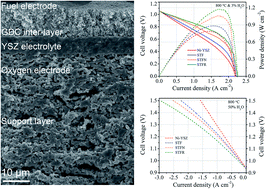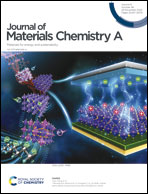Advanced oxygen-electrode-supported solid oxide electrochemical cells with Sr(Ti,Fe)O3−δ-based fuel electrodes for electricity generation and hydrogen production†
Abstract
Sr(Ti0.3Fe0.7)O3−δ (STF) and the associated exsolution electrodes Sr0.95(Ti0.3Fe0.63Ru0.07)O3−δ (STFR), or Sr0.95(Ti0.3Fe0.63Ni0.07)O3−δ (STFN) are alternatives to Ni-based cermet fuel electrodes for solid oxide electrochemical cells (SOCs). They can provide improved tolerance to redox cycling and fuel impurities, and may allow direct operation with hydrocarbon fuels. However, such perovskite-oxide-based electrodes present processing challenges for co-sintering with thin electrolytes to make fuel electrode supported SOCs. Thus, they have been mostly limited to electrolyte-supported SOCs. Here, we report the first example of the application of perovskite oxide fuel electrodes in novel oxygen electrode supported SOCs (OESCs) with thin YSZ electrolytes, and demonstrate their excellent performance. The OESCs have La0.8Sr0.2MnO3−δ–Zr0.92Y0.16O2−δ (LSM–YSZ) oxygen electrode-supports that are enhanced via infiltration of SrTi0.3Fe0.6Co0.1O3−δ, while the fuel electrodes are either Ni-YSZ, STF, STFN, or STFR. Fuel cell power density as high as 1.12 W cm−2 is obtained at 0.7 V and 800 °C in humidified hydrogen and air with the STFR electrode, 60% higher than the same cell made with a Ni-YSZ electrode. Electrolysis current density as high as −1.72 A cm−2 is obtained at 1.3 V and 800 °C in 50% H2O to 50% H2 mode; the STFR cell yields a value 72% higher than the same cell made with a Ni-YSZ electrode, and competitive with the widely used conventional Ni-YSZ-supported cells. The high performance is due in part to the low resistance of the thin YSZ electrolyte, and also to the low fuel electrode polarization resistance, which decreases with fuel electrode in the order: Ni-YSZ > STF > STFN > STFR. The high performance of the latter two electrodes is due to exsolution of catalytic metal nanoparticles; the results are discussed in terms of the microstructure and properties of each electrode material, and surface oxygen exchange resistance values are obtained over a range of conditions for STF, STFN, and STFN. The STF fuel electrodes also provide good stability during redox cycling.



 Please wait while we load your content...
Please wait while we load your content...